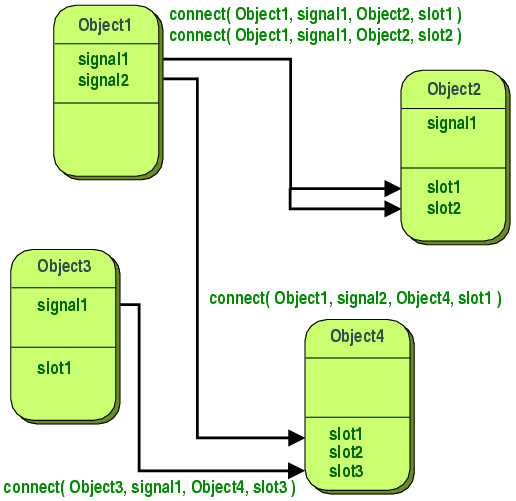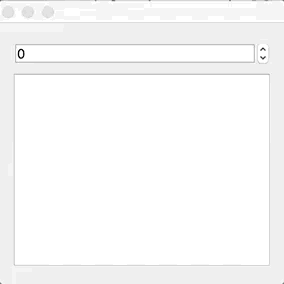Multiple Signals And Slots Python
3/29/2022 admin
This section describes the new style of connecting signals and slotsintroduced in PyQt4 v4.5.
One of the key features of Qt is its use of signals and slots to communicatebetween objects. Their use encourages the development of reusable components.
A signal is emitted when something of potential interest happens. A slot is aPython callable. If a signal is connected to a slot then the slot is calledwhen the signal is emitted. If a signal isn’t connected then nothing happens.The code (or component) that emits the signal does not know or care if thesignal is being used.
A Signal Handler is a user defined function, where Python signals can be handled. If we take the signal SIGINT (Interrupt Signal), the default behavior would be to stop the current running program. We can, however, assign a signal handler to detect this signal and do our custom processing instead! PyQt5 Tutorial Python 3 GUI Development - Signals and Slots ExampleThis Video is on PyQt5 Tutorial With Python 3 GUI Development on Signal and Slots Examples to connect Methods, checking out grid.
A simple implementation of the Signal/Slot pattern. I originally uploaded this to ASPN's python cookbook in 2005. To use, simply create a Signal instance and connect methods, which act as the 'slot' in this design pattern. The instance of signal is self-sufficient; it doesn't have to be a member of a class. Basically, connecting two signals is a simplified version of connecting a signal and a slot, while the slot is meant to emit another signal. As for priority, the slot(s) of the latter signal will be handled when the event loop is returned to the object. However, it is impossible to connect two slots because the mechanism requires a signal while. A slot can be any Python callable. A slot is called when a signal connected to it is emitted. Signals & Slots. This is a simple example, demonstrating signals and slots in PySide. #!/usr/bin/python ' ZetCode PySide tutorial In this example, we connect a signal of a QtGui.QSlider to a slot of a QtGui.QLCDNumber.
The signal/slot mechanism has the following features.
- A signal may be connected to many slots.
- A signal may also be connected to another signal.
- Signal arguments may be any Python type.
- A slot may be connected to many signals.
- Connections may be direct (ie. synchronous) or queued (ie. asynchronous).
- Connections may be made across threads.
- Signals may be disconnected.
Unbound and Bound Signals¶
A signal (specifically an unbound signal) is an attribute of a class that is asub-class of QObject. When a signal is referenced as an attribute of aninstance of the class then PyQt4 automatically binds the instance to the signalin order to create a bound signal. This is the same mechanism that Pythonitself uses to create bound methods from class functions.
A bound signal has connect(), disconnect() and emit() methods thatimplement the associated functionality. It also has a signal attributethat is the signature of the signal that would be returned by Qt’s SIGNAL()macro.
A signal may be overloaded, ie. a signal with a particular name may supportmore than one signature. A signal may be indexed with a signature in order toselect the one required. A signature is a sequence of types. A type is eithera Python type object or a string that is the name of a C++ type. The name of aC++ type is automatically normalised so that, for example, QString can beused instead of the non-normalised constQString&.
If a signal is overloaded then it will have a default that will be used if noindex is given.
When a signal is emitted then any arguments are converted to C++ types ifpossible. If an argument doesn’t have a corresponding C++ type then it iswrapped in a special C++ type that allows it to be passed around Qt’s meta-typesystem while ensuring that its reference count is properly maintained.
Defining New Signals with pyqtSignal()¶
PyQt4 automatically defines signals for all Qt’s built-in signals. New signalscan be defined as class attributes using the pyqtSignal()factory.
PyQt4.QtCore.pyqtSignal(types[, name])¶Create one or more overloaded unbound signals as a class attribute.
| Parameters: |
|
|---|---|
| Return type: | an unbound signal |
The following example shows the definition of a number of new signals:
New signals should only be defined in sub-classes of QObject. They must bepart of the class definition and cannot be dynamically added as classattributes after the class has been defined.
New signals defined in this way will be automatically added to the class’sQMetaObject. This means that they will appear in Qt Designer and can beintrospected using the QMetaObject API.
Overloaded signals should be used with care when an argument has a Python typethat has no corresponding C++ type. PyQt4 uses the same internal C++ class torepresent such objects and so it is possible to have overloaded signals withdifferent Python signatures that are implemented with identical C++ signatureswith unexpected results. The following is an example of this:
Connecting, Disconnecting and Emitting Signals¶
Signals are connected to slots using the connect() method of a boundsignal.
connect(slot[, type=PyQt4.QtCore.Qt.AutoConnection[, no_receiver_check=False]])¶Connect a signal to a slot. An exception will be raised if the connectionfailed.
| Parameters: |
|
|---|
Signals are disconnected from slots using the disconnect() method of abound signal.

disconnect([slot])¶Disconnect one or more slots from a signal. An exception will be raised ifthe slot is not connected to the signal or if the signal has no connectionsat all.
| Parameters: | slot – the optional slot to disconnect from, either a Python callable oranother bound signal. If it is omitted then all slots connected to thesignal are disconnected. |
|---|
Signals are emitted from using the emit() method of a bound signal.
emit(*args)¶Emit a signal.
| Parameters: | args – the optional sequence of arguments to pass to any connected slots. |
|---|
The following code demonstrates the definition, connection and emit of asignal without arguments:
The following code demonstrates the connection of overloaded signals:
Connecting Signals Using Keyword Arguments¶
It is also possible to connect signals by passing a slot as a keyword argumentcorresponding to the name of the signal when creating an object, or using thepyqtConfigure() method of QObject. For example the following threefragments are equivalent:
The pyqtSlot() Decorator¶
Although PyQt4 allows any Python callable to be used as a slot when connectingsignals, it is sometimes necessary to explicitly mark a Python method as beinga Qt slot and to provide a C++ signature for it. PyQt4 provides thepyqtSlot() function decorator to do this.
PyQt4.QtCore.pyqtSlot(types[, name[, result]])¶Decorate a Python method to create a Qt slot.
| Parameters: |
|
|---|
Connecting a signal to a decorated Python method also has the advantage ofreducing the amount of memory used and is slightly faster.
For example:
It is also possible to chain the decorators in order to define a Python methodseveral times with different signatures. For example:
Connecting Slots By Name¶
PyQt4 supports the QtCore.QMetaObject.connectSlotsByName() function thatis most commonly used by pyuic4 generated Python code toautomatically connect signals to slots that conform to a simple namingconvention. However, where a class has overloaded Qt signals (ie. with thesame name but with different arguments) PyQt4 needs additional information inorder to automatically connect the correct signal.
For example the QtGui.QSpinBox class has the following signals:
When the value of the spin box changes both of these signals will be emitted.If you have implemented a slot called on_spinbox_valueChanged (whichassumes that you have given the QSpinBox instance the name spinbox)then it will be connected to both variations of the signal. Therefore, whenthe user changes the value, your slot will be called twice - once with aninteger argument, and once with a unicode or QString argument.

This also happens with signals that take optional arguments. Qt implementsthis using multiple signals. For example, QtGui.QAbstractButton has thefollowing signal:
Qt implements this as the following:


The pyqtSlot() decorator can be used to specify which ofthe signals should be connected to the slot.

For example, if you were only interested in the integer variant of the signalthen your slot definition would look like the following:
If you wanted to handle both variants of the signal, but with different Pythonmethods, then your slot definitions might look like the following:
The following shows an example using a button when you are not interested inthe optional argument:
Mixing New-style and Old-style Connections¶
The implementation of new-style connections is slightly different to theimplementation of old-style connections. An application can freely use bothstyles subject to the restriction that any individual new-style connectionshould only be disconnected using the new style. Similarly any individualold-style connection should only be disconnected using the old style.
You should also be aware that pyuic4 generates code that usesold-style connections.
Previous Chapter: OOP, Inheritance Example
Next Chapter: Classes and Class Creation
Next Chapter: Classes and Class Creation
Slots
Avoiding Dynamically Created Attributes
The attributes of objects are stored in a dictionary __dict__. Like any other dictionary, a dictionary used for attribute storage doesn't have a fixed number of elements. In other words, you can add elements to dictionaries after they are defined, as we have seen in our chapter on dictionaries. This is the reason, why you can dynamically add attributes to objects of classes that we have created so far:
The dictionary containing the attributes of 'a' can be accessed like this:
You might have wondered that you can dynamically add attributes to the classes, we have defined so far, but that you can't do this with built-in classes like 'int', or 'list':
Using a dictionary for attribute storage is very convenient, but it can mean a waste of space for objects, which have only a small amount of instance variables. The space consumption can become critical when creating large numbers of instances. Slots are a nice way to work around this space consumption problem. Instead of having a dynamic dict that allows adding attributes to objects dynamically, slots provide a static structure which prohibits additions after the creation of an instance.
When we design a class, we can use slots to prevent the dynamic creation of attributes. To define slots, you have to define a list with the name __slots__. The list has to contain all the attributes, you want to use. We demonstrate this in the following class, in which the slots list contains only the name for an attribute 'val'.
If we start this program, we can see, that it is not possible to create dynamically a new attribute. We fail to create an attribute 'new'.
Multiple Signals And Slots Python Ide
We mentioned in the beginning that slots are preventing a waste of space with objects. Since Python 3.3 this advantage is not as impressive any more. With Python 3.3 Key-Sharing Dictionaries are used for the storage of objects. The attributes of the instances are capable of sharing part of their internal storage between each other, i.e. the part which stores the keys and their corresponding hashes. This helps reducing the memory consumption of programs, which create many instances of non-builtin types.
Previous Chapter: OOP, Inheritance Example
Next Chapter: Classes and Class Creation
Next Chapter: Classes and Class Creation